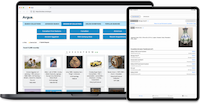The Role of Museum Collections Online in Storytelling & Audience Engagement

Rachael Cristine Woody
Among the many benefits of digitized collections is the ability to use digital surrogates as an ingredient for enhanced storytelling.
Storytelling with museum collections online allows for a great degree of flexibility, offers additional detail, and lends a dynamism that is difficult to produce within a physical exhibition. It’s also possible to offer a fully-fledged online exhibit which is often done when an in-person exhibit is difficult to execute, there’s a lack of space or staff capacity, or other restrictive detractors.
Whether collections online are used as one part of an exhibit or are the entirety of the exhibit, it’s important for us to keep in mind the storytelling craft and to apply it regardless of physical or digital medium. Ideally, engagement with a museum story shifts from passive viewership to individuals envisioning themselves as main characters within the story.
My next few posts will examine the three main storytelling goals from an exhibition perspective and how to approach each with collections online as a part of (or the whole of) a story. The three storytelling goals we’ll review are: engagement, learning, and reflection. This post will focus on engagement.
Storytelling Goal: Engagement
Of the three storytelling goals, engagement is perhaps the most important to begin with. If engagement isn’t achieved, it’s nearly impossible to reach the other two goals: learning and reflection.
Engagement as a storytelling goal occurs in three phases:
- Primary attention capture
- Sympathy or empathy triggered (ability to relate)
- Drive to see the story through to the end
The first and perhaps most difficult phase is to catch the attention of the story viewer to the point where it stops their other running thoughts and gets them to focus on the story as the primary point of attention.
Once that is achieved, engagement then shifts from passive viewership to placing the individual within the story to the point where critical thinking is activated. At this point, the viewer is either envisioning themselves as the main character or empathizing with the main character to the point where they understand what is being conveyed on an emotional level.
The last piece of engagement motivates the viewer to see the story through to the end, or at least to the end of the section.
How to Achieve Engagement: Collections Online as Part of the Exhibit
Digital surrogates of the collection can aid in physical exhibition storytelling when they’re published online—typically through the museum’s Collections Management System (CMS).
There are a number of ways collections online can be deployed within an in-person setting. Collections online can be included via the following mechanisms:
- QR codes (links)
- Audio-Visual supplements
- Multi-vocal (multi-perspective) storytelling
- Online galleries of related items
QR Codes
QR codes (or similar linking mechanisms) are often provided as part of the exhibit panel labeling. The code contains a link to view additional details about the item or items via the museum CMS online. QR codes can also link to a supplemental side story of the particular portion of the exhibit the viewer is in via an online gallery.
Audio-Visual (AV) Supplements
AV supplements can lend a depth and dynamism to storytelling that is difficult to achieve within the confines of a physical space. We know that music, singing, dancing, and rituals are all human expressions of deep emotional feeling. When these elements are missing from an exhibit it can leave the space feeling stale.
Further, if we’re attempting to achieve engagement, we simply must have more human elements as part of the exhibit-story experience. But these elements can be the hardest to deliver in person as it requires both the humans to perform these elements as well as the space to hold the performance in. However, if collections online are used, access to AV materials can be offered on-demand—helping to solve both the human and space needs of the performance.
Multi-Vocal Storytelling
Offering different perspectives in an exhibit is typically the most difficult element to achieve within a physical exhibit space, usually due to space restrictions for items and text panels. Yet, a multi-vocal narrative can lend depth and greater understanding of the overall exhibit story. Multiple perspectives can aid in the engagement aspect of the exhibit because it provides more opportunities for a person to connect via sympathy or empathy.
Online Galleries of Related Items
When creating a physical exhibit there are inevitably items that don’t make the cut for display. The confines of the space as well as an object’s condition can make it difficult to display everything in the collection that is related to the story we’re attempting to tell.
However, as we continue to digitize our collection, digital surrogates of the objects can be made available and linked to specific areas of the exhibit for story viewers to engage with at their own discretion. Offering these digital supplements can facilitate a deeper dive into the story as well as help to engage the viewer even further into both the story and the collection.
How to Achieve Engagement: Collections Online as the Exhibit
When crafting an entirely online exhibition, we want to ensure we incorporate all of the successful storytelling elements of a physical exhibit that aid in engagement, but with some mindful changes.
Links to Additional Content
Providing links allows us to offer supplemental information where the story viewer can self-elect to view additional materials on a particular topic. While a QR code isn’t needed in an online exhibit, supplemental galleries or suggested searches can be offered to the viewer.
Audio-Visual Supplements
Audio-visual supplements can and should be included as part of the online exhibit. As it’s so easy to incorporate, you may also consider crafting a “playlist” or related offerings for viewers to engage with.
Multi-Vocal Storytelling
Similar to AV materials, the execution of multi-vocal storytelling in an online setting is fairly easy and should be used as part of the storytelling apparatus. Multi-vocal elements can be offered as different items or sub-galleries for viewers to engage with.
Displaying Museum Collections Online Means More Engagement Opportunities
Engagement is the first and most important storytelling goal, and can also be one of the most rewarding elements to work on. If you are constructing a physical exhibit, it’s important to incorporate collections online as an engagement deepener. If you are constructing an online-only exhibit, it is important to remember storytelling goals and the mechanisms available to support those goals.

Rachael Cristine Woody
Intrigued by this post? Please join us for the companion webinar, Storytelling Goals with Museum Collections Online, Wednesday, November 20, 2024 at 11 a.m. Pacific / 2 p.m. Eastern. (Can’t make it? Register anyway and we will send you a link to the recording and slides afterwards). Register now to save your seat!
Never miss another post. Subscribe today!
Similar Posts
How to Use Slideshows and Flipbooks to Offer Engaging Museum Story Visuals
Museums thrive on storytelling, and the right digital tools can make all the difference. Slideshows and flipbooks offer an engaging way to showcase collections, drawing visitors in with dynamic visuals and interactive elements.
Zooming Into Story Details:
How Museums Can Enhance Storytelling with Visual Tools
Visual tools such as zoom are crowd pleasers when presenting visual content online, allowing museums to create immersive and engaging digital experiences.
7 Digital Storytelling Elements That Live In Your Museum CMS
A museum’s Collections Management System (CMS) is more than just a catalog—it can also serve as a foundation for digital storytelling. By leveraging the rich object data and images already housed in the CMS, museum professionals can experiment with new ways to craft compelling narratives. In this article, Rachael Cristine Woody explores how different types of digital surrogates can bring museum collections to life online.
Examining the National Galleries of Scotland’s Harryhausen Digital Exhibit
In October 2020, the National Galleries Scotland (NGS), Ray Harryhausen | Titan of Cinema (October 2020 – February 2022) exhibition was meant to open and celebrate what would have been Harryhausen’s centenary year. Due to COVID the physical exhibit was forced to close...





Leave a Comment
Comments are reviewed and must adhere to our comments policy.
0 Comments